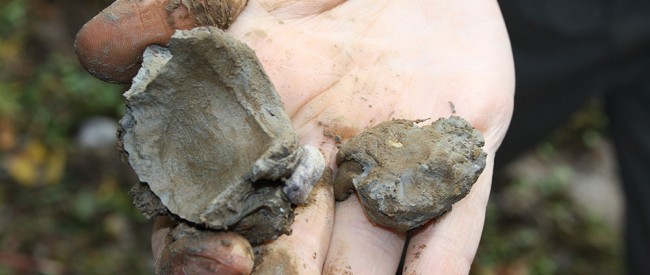
Photo Credit: Norma Kerby
Dirt Secrets— Understanding northern soils is key to good gardening
“Most of the old timers certainly knew where to put their farms for the best soils.”
I’m talking to a long-time Skeena Valley farmer about the interesting pattern of homestead pre-emptions. We had both heard the many stories featuring English gentlemen who arrived in this region before World War I and foolishly staked land on the droughty, coarse gravel flats above the river. But others coming from agricultural backgrounds had carefully surveyed the valley for fertile, arable soils. With a shovel and a good sense of growing conditions, they walked the hills until they found the right location. Some of those farms are still active today.
It has been a hobby of mine to look at district lot numbers from the early 1900s and try to guess why someone would want to purchase land in that location. Other than properties associated with mining ventures and the occasional strategic plot next to the river or on a well-used travel route, the old district lots are mostly associated with good soils, advantageous slopes facing south and secure water sources. In the days before supermarkets, choosing the right soil made the difference between being able to grow enough food to survive or being forced to give up and move away.
Critical resource on the decline
Soil is a misunderstood resource. Cited as one of the most important environmental problems in our modern age, soil losses have turned large areas of the Earth into non-productive wastelands. At more northerly latitudes, soil is a critical resource for the growth of forests and other natural ecosystems and, with the correct type of soil, the production of forage and crops. Without viable soils, our serious climatic limitations mean that what can grow on the landscape in northern BC becomes very limited.
In order to get the best from your northern soil, it is important to understand its components and how it’s formed. As the old farmers use to say, soil is a living blanket over the ground. Healthy soil is the interaction between mineral particles, organic materials, water, air and a diverse fauna and flora of fungi, bacteria, insects and other invertebrates. The complexity of healthy soil allows essential nutrients for plants to be recycled and retained and for moisture to be available for vigorous plant growth. Any action that diminishes the soil’s living component, such as overuse of artificial fertilizers or salt from winter road maintenance, reduces the cycling of nutrients and subsequent growth of plants.
Soil takes hundreds, if not thousands, of years to form. Resulting from the interplay between climatic conditions, water, vegetation cover and the type of material on the surface, natural mineral soils in northern BC can range from 75 to 100 cm deep. For example, in the northern interior long, cold winters combined with hotter, dry summers slow down soil-forming processes. Its development takes a very long time—much longer than the generations of farmers hoping to use it. Except for those naturally replenished on the floodplains, if it is damaged it can be very difficult to restore within the timeframe of food-growing ventures.
Working what you’ve got
“At your end of the bench, soil’s real’ shallow and sandy—not much good. That’s why there weren’t any big farms there like down by the river.” My friend chastises me for trying to intensively garden in an area where two rounds of land clearing and a historic forest fire had reduced the soil cover to shallow, acidic, nutrient-poor layers over deep sand.
“No problem,” I mutter. “I would rather work with sand than those marine clays north of town. At least with sand, you can build up the soil.”
Getting the most out of your soil, or what is left of it, is an exercise in understanding how it was formed and how it would have naturally functioned in your particular location.
In the floodplains, the natural process of floodwaters depositing new layers of silt and organic materials builds deep layers of nutrient-rich but poorly developed soil. Farming on floodplains can allow constant cropping without the need for artificial nutrients. Although there is always the danger of erosion, plus the stress of dealing with floods, these areas have the richest soils in the North.
But most of us do not have naturally fertile soils. As a result of leaching, conifer-dominated forests and surface materials that are mostly ground-up bedrock from the ice ages, nutrients are limited and largely held within the plants and organic layers near the top. Land-clearing efforts often remove these nutrient sources rather than mixing them into the mineral layers. Many soil types, such as the sandy loam in my backyard, can become heavily depleted of nutrients after only three or four rounds of hay or field crops.
Sandy soils are naturally fragile because spaces between the grains are too large to hold water and sand releases few nutrients. In order to intensely garden sandy soils, it is essential to mimic the organic layers that once would have laid on top of the mineral soil. Organic mulch is excellent at retaining and releasing nutrients, as well as holding moisture during dry periods. It also breaks surface erosion from pounding rainfalls and provides habitat for beneficial insects and toads. Organic mulch helps turn sandy soil into a well-aerated, rich loam perfect for gardening.
Ups and downs of drainage
Clay soils have a different set of problems. In northern BC, most have developed from microscopic grains of ground-up rock flour deposited by retreating glaciers. Limited in nutrients, these soils have poor drainage and accumulate surface water in low areas. Gardening on top of clay in the wetter coastal valleys involves building adequate drainage features or using slopes, garden mounds and raised beds to increase drainage.
In the drier interior, many of the clay soils are of glacial-lake origins. With strong water-retention characteristics, clay can be an advantage in this zone, but nutrients may still be a limiting factor. If the soil has been damaged, it becomes necessary to build new soil structures over the clay. Some of the best intensive gardens on clay are those that have layers of organic mulch mixed with silt or sand over the clay. The use of nitrogen-fixing cover crops such as clover or alfalfa is very effective, as the roots of these plants are able to penetrate into the ground and extend the growing zone into the subsoil.
Look around at natural vegetation in your area, observe where the plant growth is best, take a shovel and dig down into the soil. Examine which layers have the most plant roots. Feel the texture in the different horizons. Some of the most productive northern soils, often on warm, moist, south-facing slopes, are crumbly mulches full of worms and bugs. This is the goal toward which most of us are striving: nutrient-rich, sustainable soils with active ecosystems of soil-forming organisms.
Of course, though, there is always the quick solution to challenging northern soils. One passionate gardener I know lives in the boulder fields of Jackpine Flats near Terrace. Three truckloads of manufactured topsoil have given her a garden that would make any northern farmer jealous.





